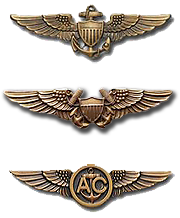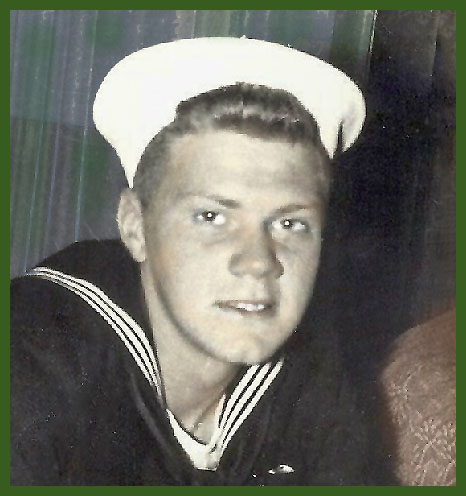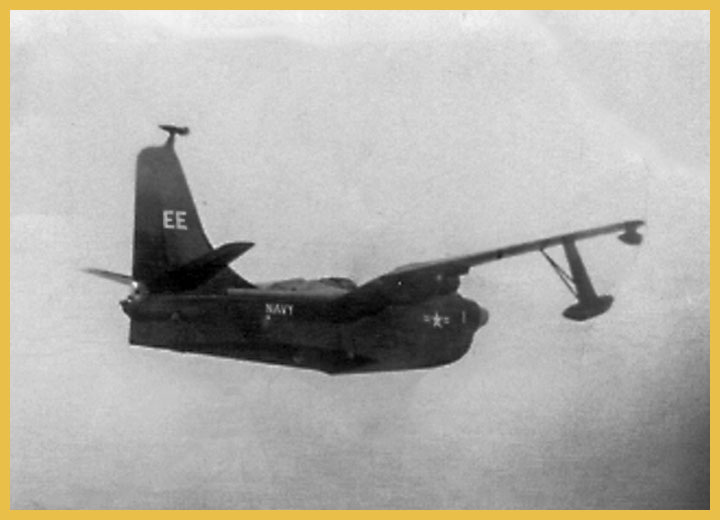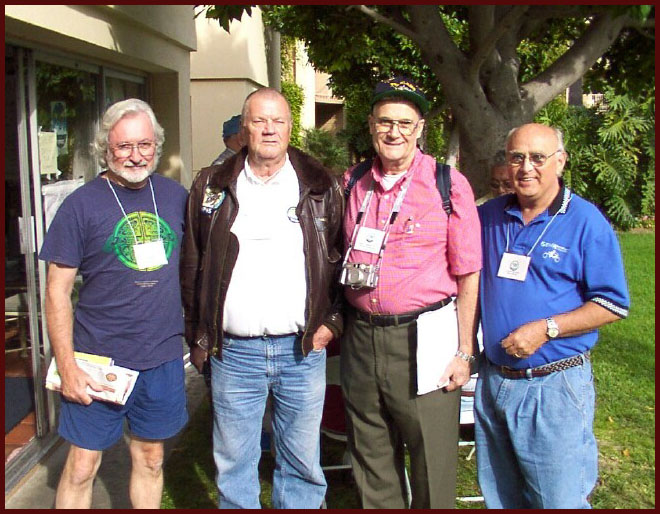Remembering 1-Boat - 1956

My wonderful, big, dark sea blue aircraft - from 1954 through 1956 - was a P5M-1, a Martin Marlin produced by the Glenn L. Martin Company. Her name was “1-Boat” or EE-1 (the tail ID letters); EE, meaning VP-45 and the aircraft side number 1 which was always the Skipper’s plane.
I was one of the 11 members of her crew, 4 pilots and 7 enlisted crewmen. We kept her always well and ready to fly; she kept us always alive through whatever tasks the Navy would assign and whatever the lofty heavens and the dark storms would place on the menu. Our home base was Naval Station Coco Solo, Panama Canal Zone, and our area of responsibility, in those crotchety Cold War days, ranged from the Gulf of Mexico across to Bermuda and south to Puerto Rico, Cuba,Trinidad and beyond.
After the Navy’s seaplane era ended in the early 60’s, VP-45 moved into more traditional (non-seaplane) types of aircraft – first was the great and venerable P-3 Lockheed Orion, a then modern military version of the turbo-prop powered Lockheed Electra, which had served with the world’s airlines for many years shortly before the Boeing 707 arrived on the scene. And these days the squadron is very happily flying the high-performance twin-jet Boeing P-8A Poseidon - a very modern military version of Boeing’s 737. This MPA aircraft now carries dozens of new, high-tech electronics with flight crews who are charged with using the best of our detection systems to complete their missions.
Each squadron now takes 6 or so “Wing owned” aircraft on deployment,  whereas in my time each squadron had, and owned, 12 P-5Ms. Today’s crew members are somewhat more attached to their squadron and crew but they have, sad to say, lost the unique connection to their “bird” that, in our time, we clung to so fiercely.
whereas in my time each squadron had, and owned, 12 P-5Ms. Today’s crew members are somewhat more attached to their squadron and crew but they have, sad to say, lost the unique connection to their “bird” that, in our time, we clung to so fiercely.
But…back to the ’50’s. All of the crew members of our squadron were, to a man, loyal to their assigned plane. We’d been known to enter into unauthorized fisticuffs at times, in watering holes scattered around the blue Caribbean, with good Yankee fellows from other squadrons or from submarine crews we had played war games against, over such petty disagreements as to “who’s best” or “who’s got the Navy ‘E’ this year.”
At all times, each plane crew was in competition with all the others. And, of course, luckily, I (in the photo to the right in 1955) served on the very best P5M - not just in the squadron but in all of the Navy’s Atlantic and Pacific fleets. We all did our best to keep those big 3350 Wright Cyclone engines purring, the prop blades without damage, the exhaust pipe power-recovery-turbines clean and free-wheeling and the jet APU fueled and maintained. All electronics were full-bore functioning, flight suits and flight jackets clean and neat; even our headsets were shiny and rust-free.
I served as 2nd Radio on “1-Boat” and was charged with keeping our Radar and IFF (Identification Friend or Foe) performance and war game efficiency levels at the
top of the ratings. I even had to make certain our Morse Code performance stayed on a par with the non-aviation radio hotshots who manned the networks at all the land bases with which we communicated and often visited. The charter clearly was to keep EE-1 the leader in the squadron and to keep VP-45 as the lead squadron of Fleet Air Wing 11, nothing more, nothing less.
My four-year Navy hitch was coming to a close in September 1956, just as VP-45 was finishing a Summer-long assignment at NAS Corpus Christi, TX, taking Annapolis cadets, 5 or 6 at a time, on simulated rocket runs, indoctrinating them in the camaraderie of Naval Aviation, and showing them why they should opt for aviation upon graduation from the Naval Academy. It
was a very good assignment; one our squadron had merited in the Summers of 1955 and 1956
(remember...we were the very best of Fleet Air Wing 11). Yet, at times I found myself preoccupied as I had made the decision to leave the Navy, to finish my undergraduate degree, and then to return, to gain Naval Aviator wings at Pensacola. I wanted, in the future, to fly the A3D Douglas Skywarrior from Navy carriers.
At that time, it had been made clear that the Navy had opted out of Martin’s proposed jet powered P6M as a P5M replacement and that the seaplane era would end with our beloved P-5 Marlin. So I knew that my future career would not include seaplanes. That part of my flying life was coming to a close and that it was about to become my sad duty to remain in Texas and be mustered out of the Navy while that big, blue, beautiful airplane, EE-1 would take to the skies and return back home to Panama without me.
Yet I just didn’t realize…guess I couldn’t have realized…how badly I’d feel to see 1-Boat leave me. Early that morning on the flight line, I watched “my” crew 1, along with 11 others, handling all of the usual pre-flight duties for the first time without me…preparing for departure.
Then the crews began “turning-up” engines and preparing for the big tractors to line up the planes, in prescribed order (Captain’s plane last) toward the seaplane launching ramps. Alas, they were not my crew any longer just - as 1-Boat wasn’t my plane. I had, of course, been replaced on EE-1 by a very competent new crew member and I learn ed over the following months that he fit right in as a “creme de la crème” radioman and AT (Aviation Electronic
ed over the following months that he fit right in as a “creme de la crème” radioman and AT (Aviation Electronic
Technician). Oh how I envied him.
After watching all this in the unusual role of spectator, I rode shotgun on the tractor as it pushed and guided EE-1 from its hangar area parking spot and began the point-by-point clockwork moves to send her smoothly down the ramp, free from the beaching gear, free from the buoy, free finally to navigate her way to the open seadrome and back to Panama. From the ramp, I watched our final three planes maneuvering closely together, and then two of them received tower clearance and splashed heavily down the seadrome and into the air.
So then it was the Captain’s turn to leave the assigned duties in Corpus Christi and to report that VP-45 was en route to its new permanent duty station. The 3350 engines came up to almost full military power and, near the end of the takeoff run, 1-Boat’s nose came up, the huge wings and floats lifted perceptibly with the airspeed, and she was off. The picture to the left was taken at that very moment.
With that, a very important part of my 22 years was leaving my life forever, and every aspect of my being wa s feeling the loss. Forty-five tons of aluminum and steel she was…and her official number was 135471 – as assigned by the Navy’s Bureau of Aeronautics. But EE-1 was how VP-45 identified her and how we all remembered her. Again, that’s a photo of her leaving me, back in 1956, and I’ve always known since that moment that she had placed a claim on a part of me that would never be replaced.
s feeling the loss. Forty-five tons of aluminum and steel she was…and her official number was 135471 – as assigned by the Navy’s Bureau of Aeronautics. But EE-1 was how VP-45 identified her and how we all remembered her. Again, that’s a photo of her leaving me, back in 1956, and I’ve always known since that moment that she had placed a claim on a part of me that would never be replaced.
WRITER’S MEMO: There now remains only one P5M in this world, and fortunately and happily she has a final glorious resting place at the Naval Aviation Museum in Pensacola, Florida. Her exterior has been thoroughly reconditioned after ‘way too many years of surviving out in the sunny and rainy and stormy weather of Panhandle Florida; and now has her very own hangar. Do yourself a favor, airplane buffs, Navy patriots and history students - visit her. She’s not “my” old plane, 1 Boat, but she’ll impress you and even stake a claim on your heartstrings if you’re not very, very careful.
Submitted by Ken Gold (VP-45 '52 - '56)
At a recent VP-45 Reunion, Ken is pictured second from left.
Send questions, comments or suggestions regarding this website to: vp45assoc@vp45association.org
Copyright © 2019 PATRON FOUR FIVE ASSOCIATION


